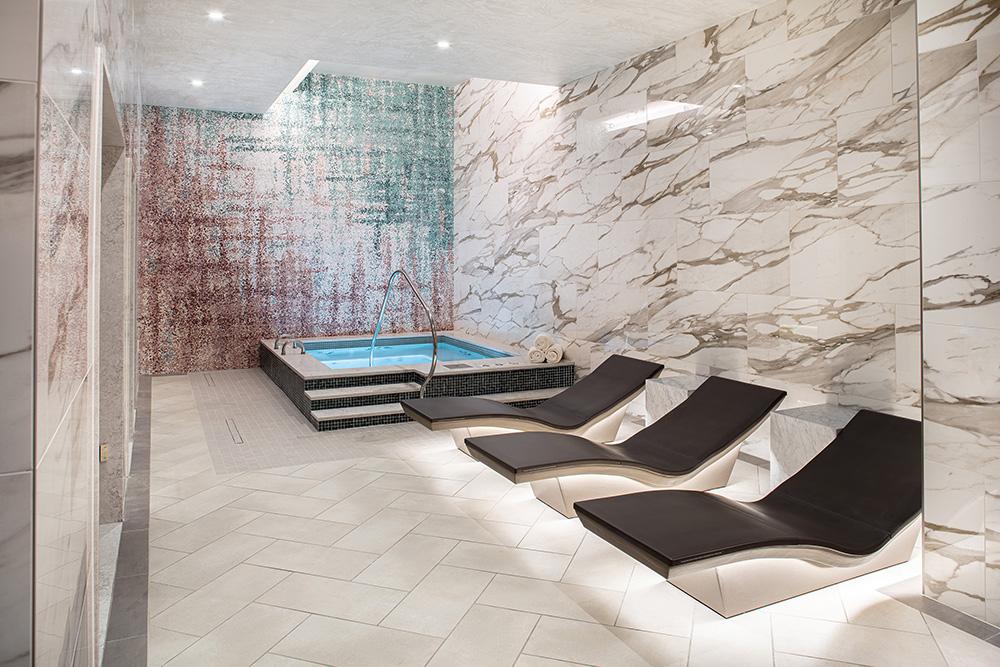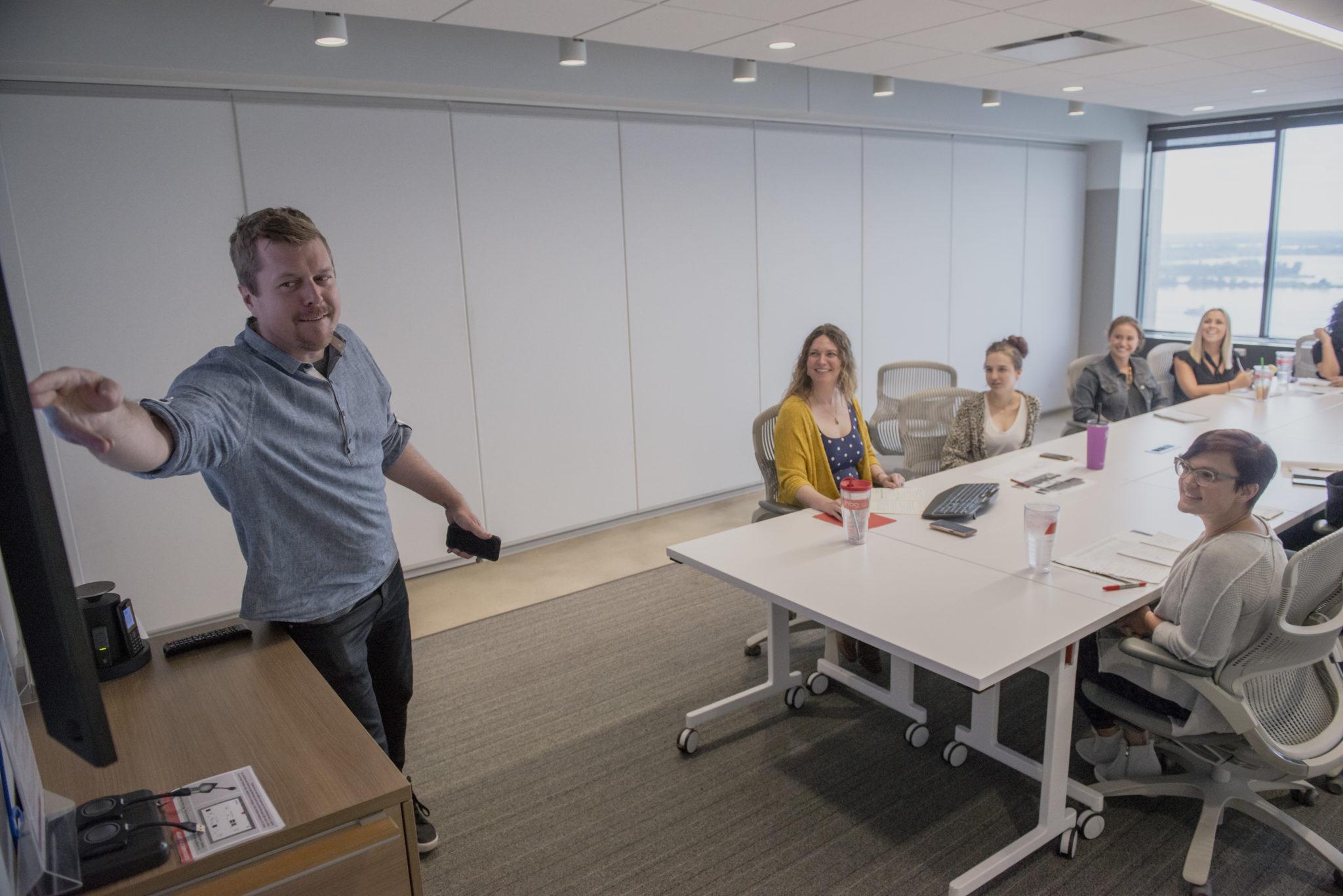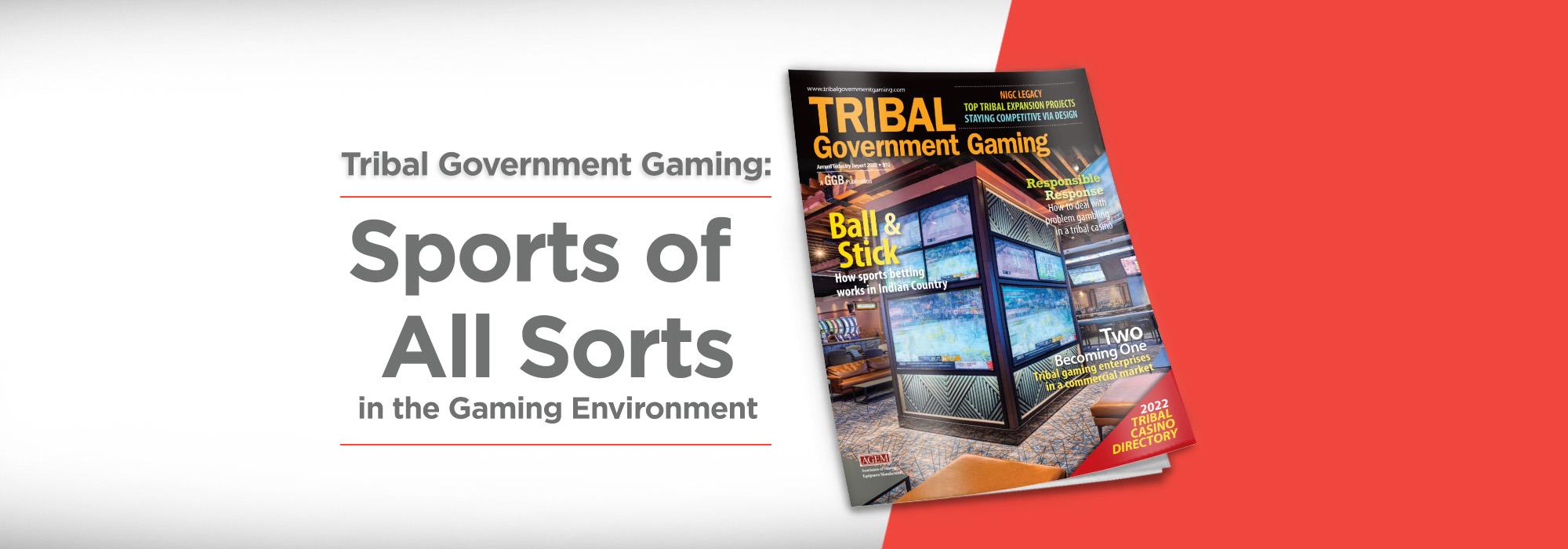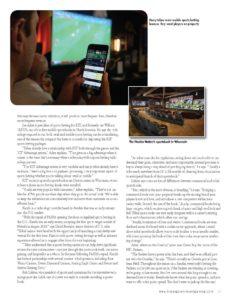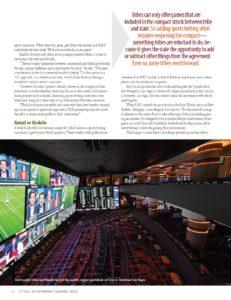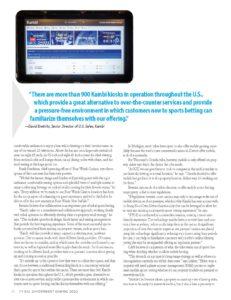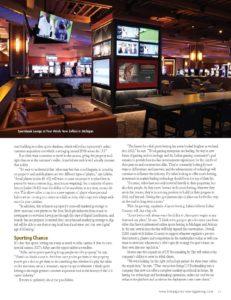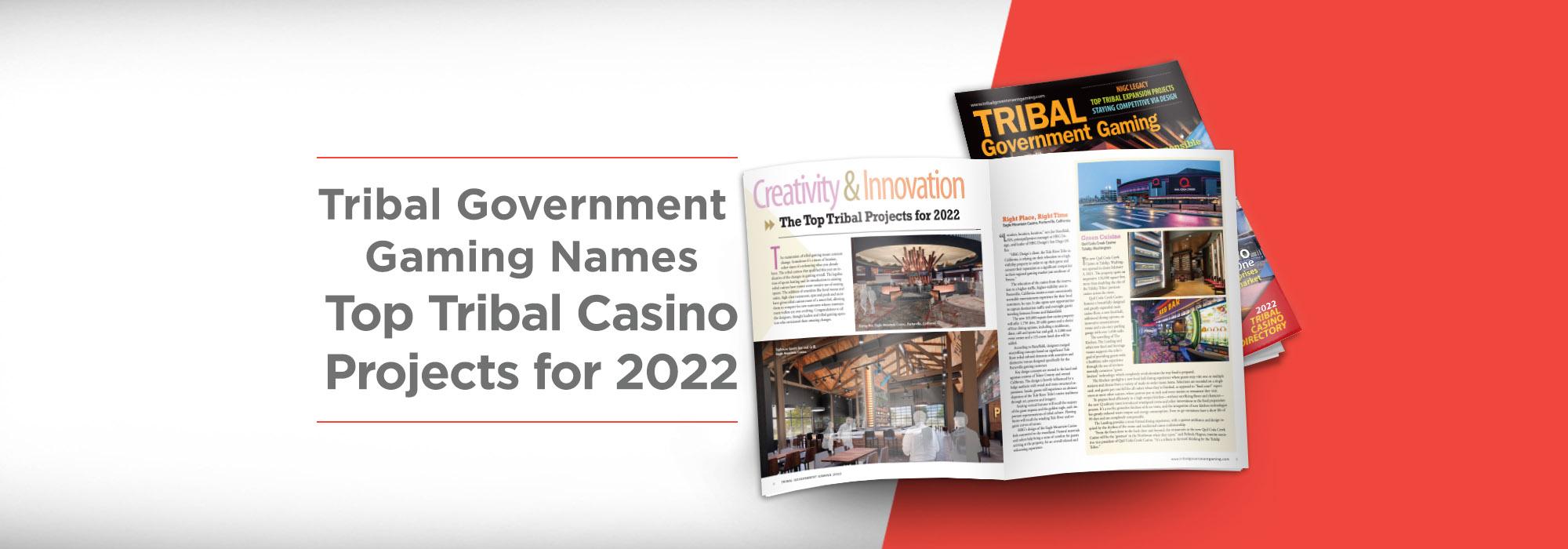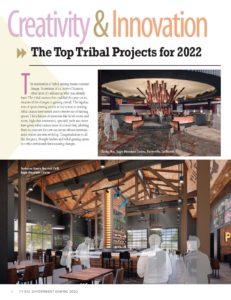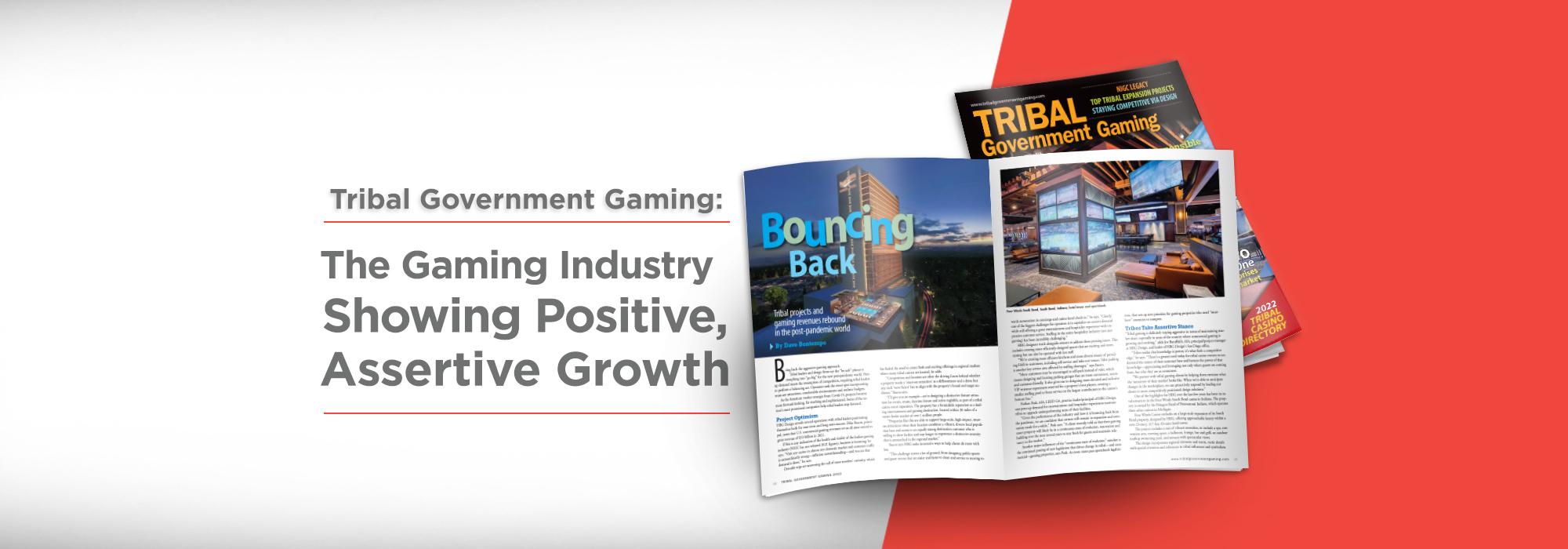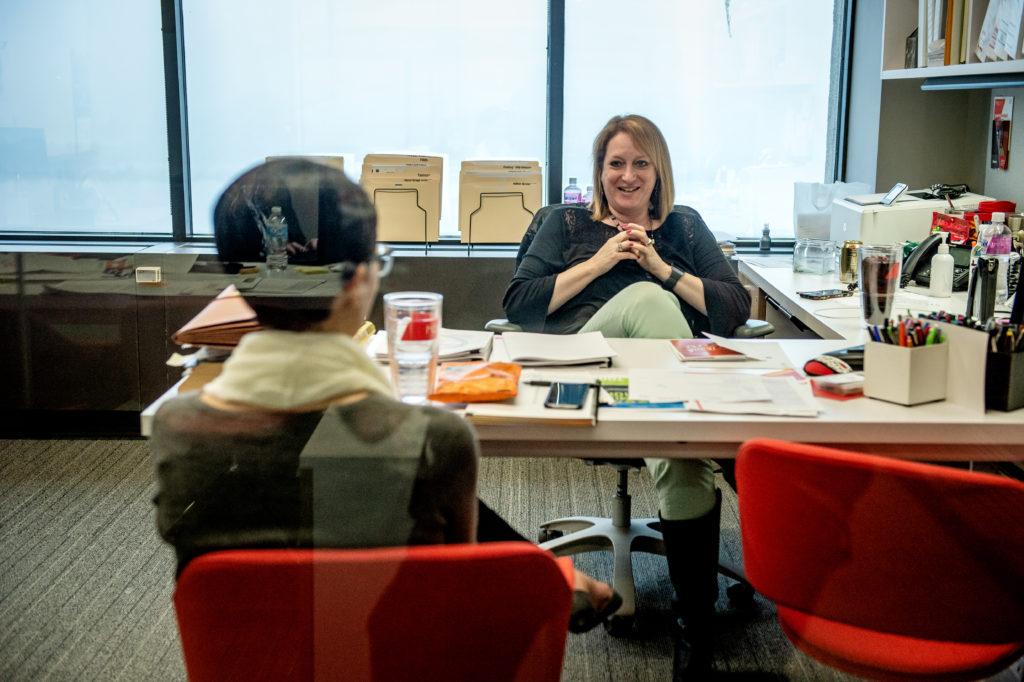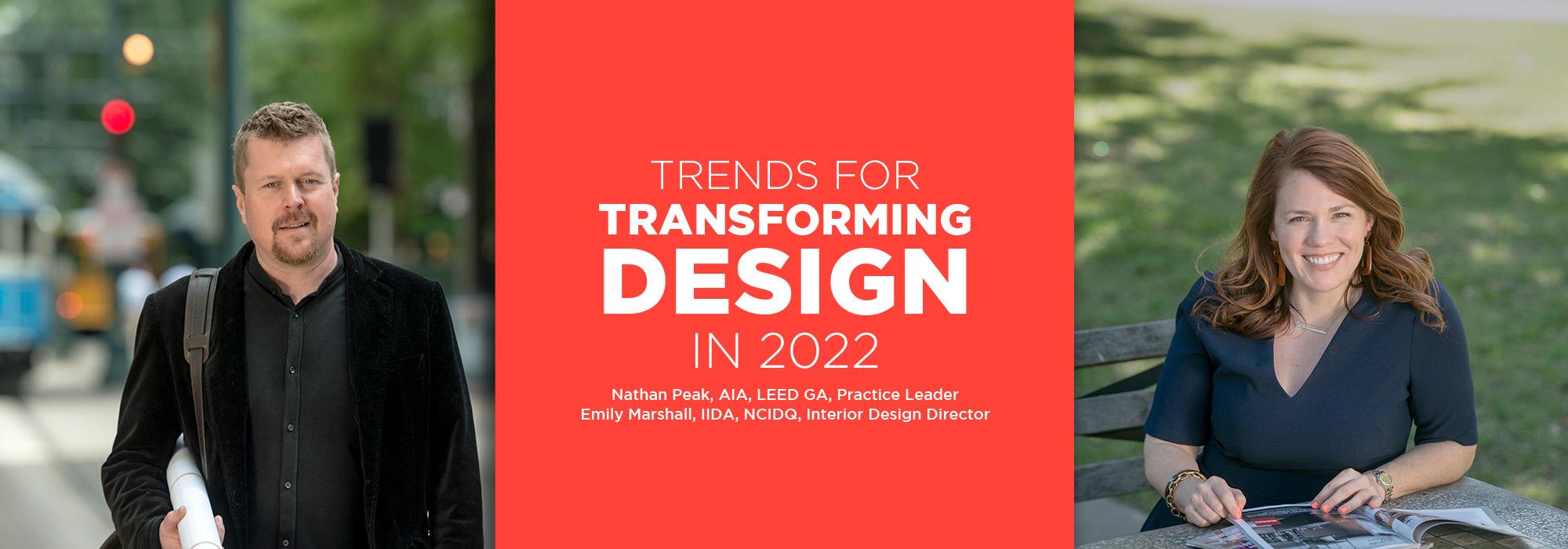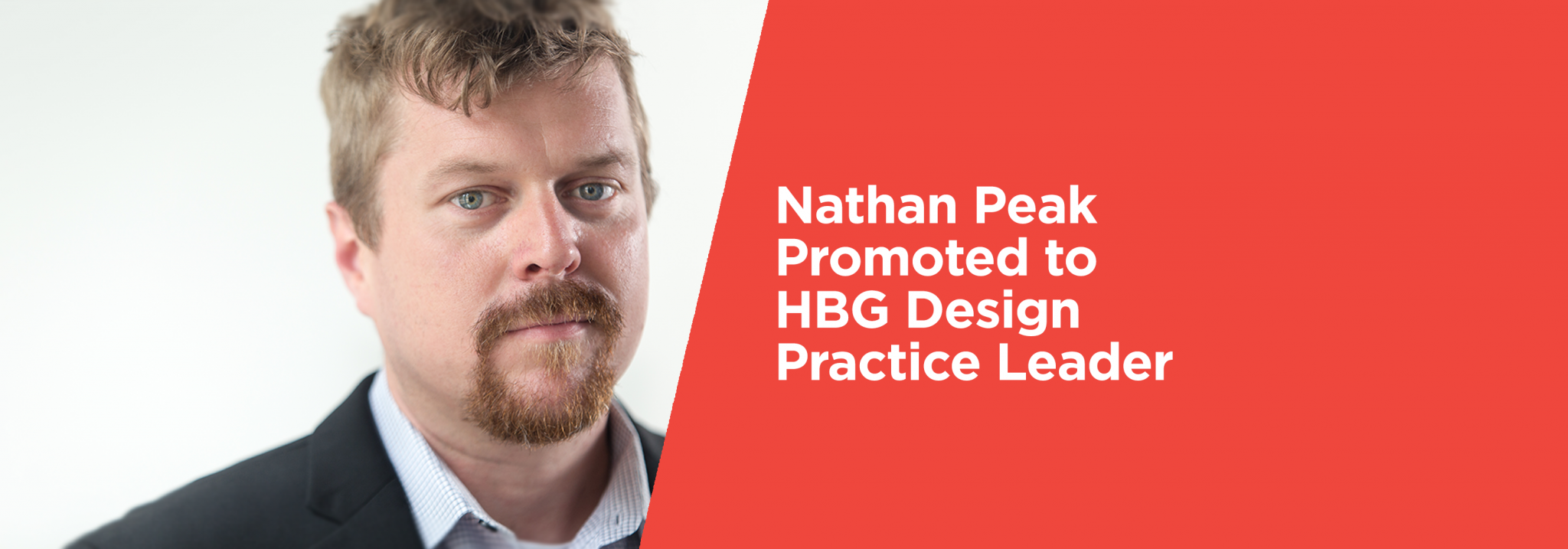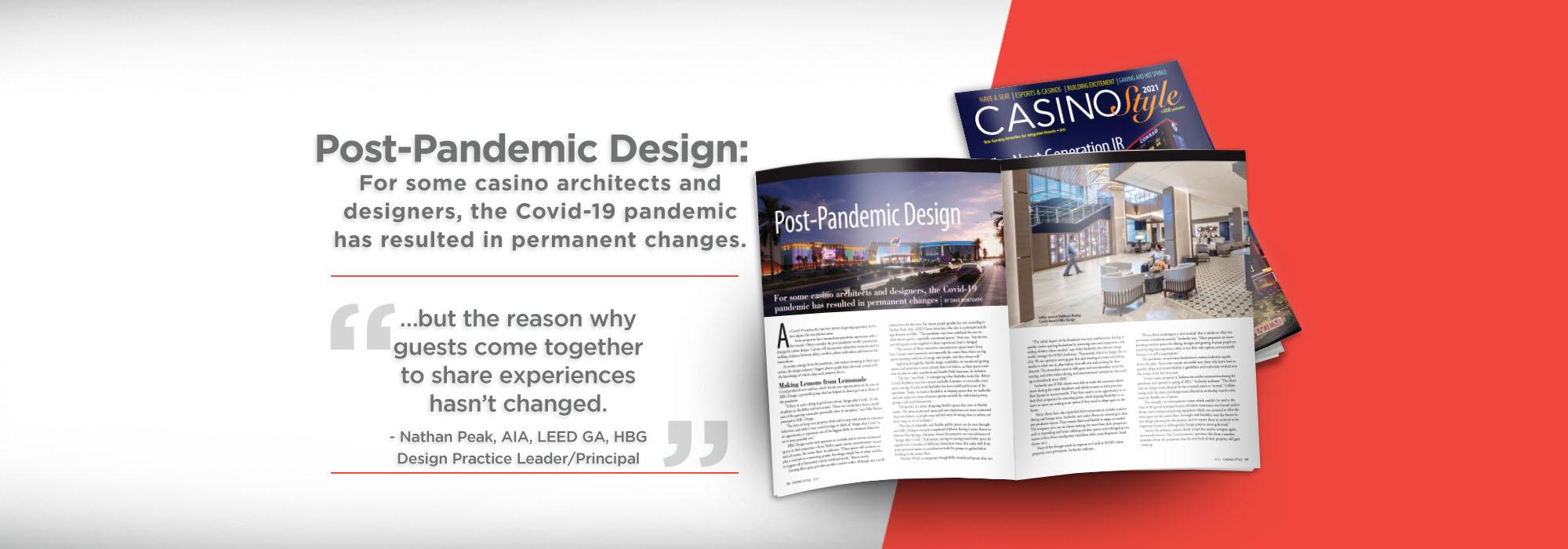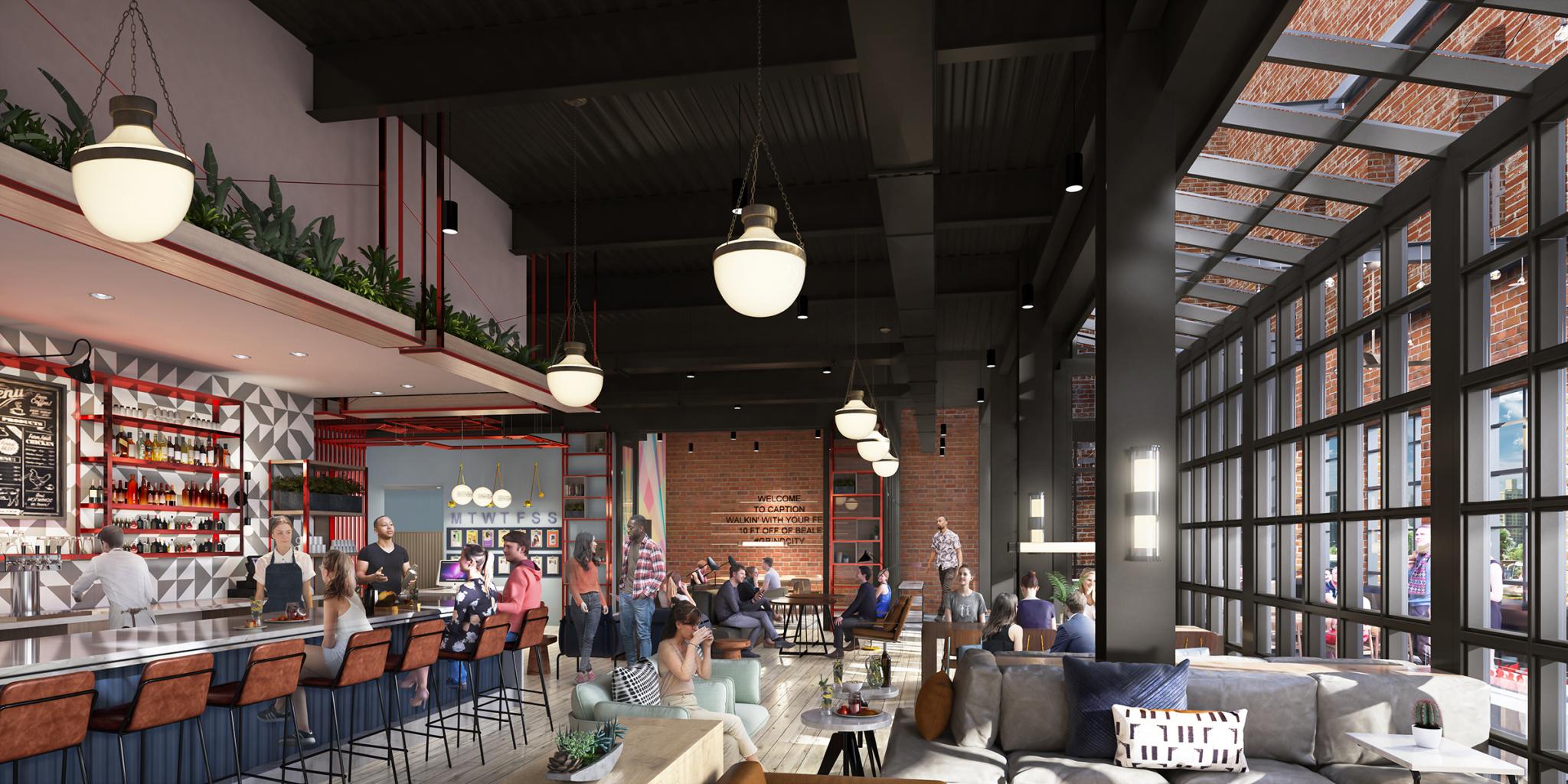American Spa Magazine Takes Us Inside Astral Spa
We had the chance to speak to Jessica Renee Rose, spa director at Astral Spa, about the new spa. Here's the scoop on Astral Spa.
Tell us a little bit about the spa’s design?
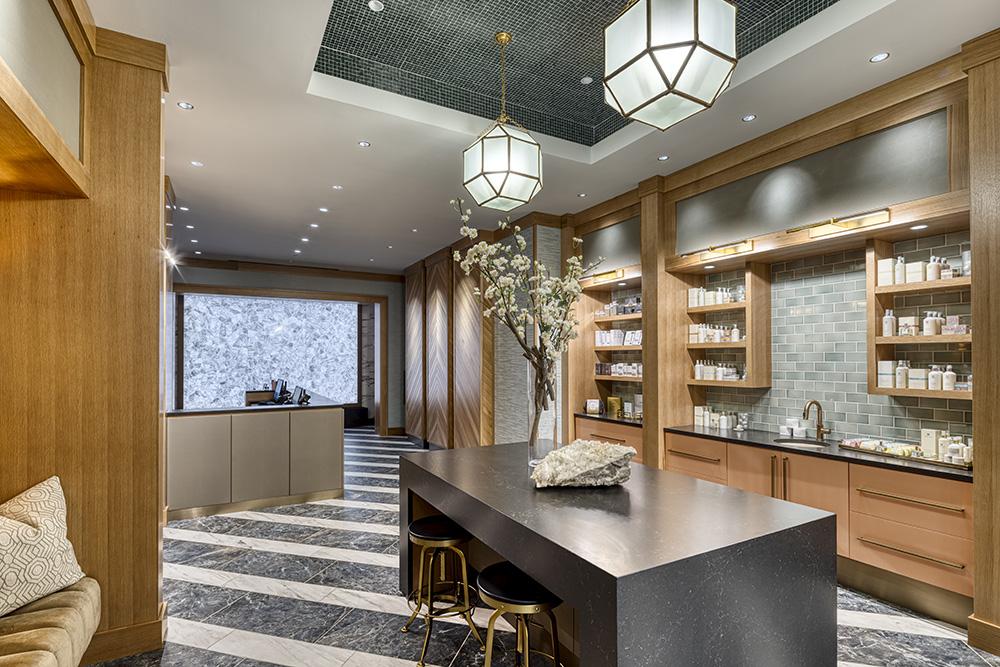 Our vision for Astral Spa was to create a unique experience that regional guests have never seen before. With multiple amenities, taking advantage of Hot Springs’ great history of entertainment, gambling, and relaxation, Astral Spa offers a throwback vibe with modern luxury which includes a cold room, steam room and infrared sauna, dipping pools, and needle showers.
Our vision for Astral Spa was to create a unique experience that regional guests have never seen before. With multiple amenities, taking advantage of Hot Springs’ great history of entertainment, gambling, and relaxation, Astral Spa offers a throwback vibe with modern luxury which includes a cold room, steam room and infrared sauna, dipping pools, and needle showers.
Marrying crisp modern lines with historical overtures, Astral Spa’s design led by HBG Design and WTS International celebrates the history of Hot Springs and Oaklawn’s thoroughbred horseracing in an era when ladies and gentlemen donned their best bespoke styles to see and be seen. Relaxing in the lounges, we want our guests to imagine what Hot Springs was like in the roaring ‘20’s yet be in contemporary comfort. The interior design is complemented by the 21st century bathhouse-inspired program and spa services menu developed by leading spa consultants and operators, WTS.
Can you please describe each of the treatment rooms?
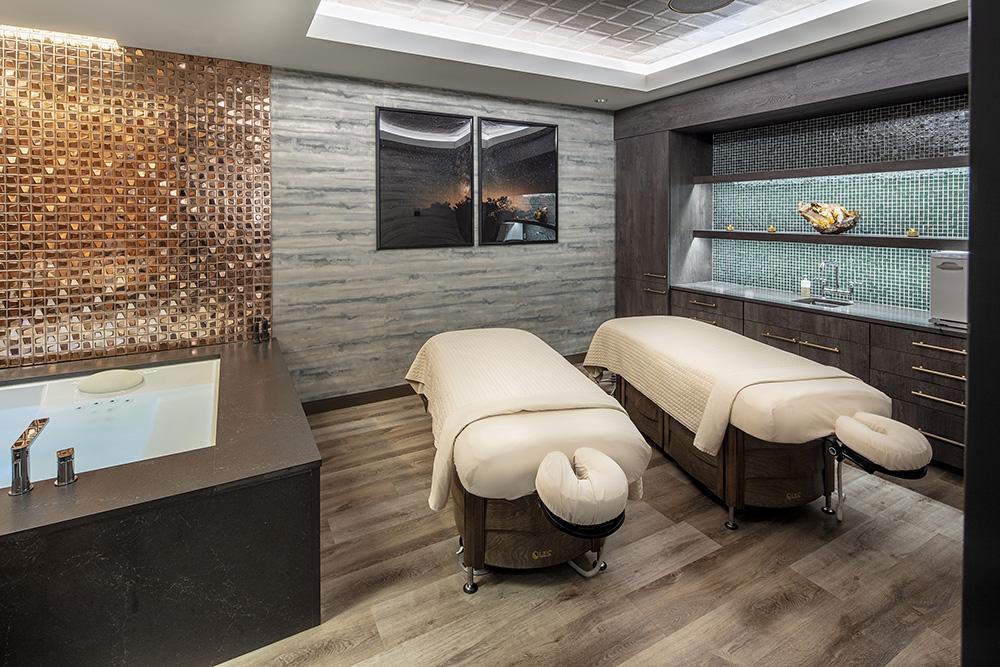 Designed for complete relaxation, the 2,035-square-foot treatment area rooms contain beautifully dressed beds with soft organic linens and warm cocooning cashmere blankets. The Duet Spa Suite allows two guests to share in a meaningful spa experience. This beautifully appointed suite offers coordinated treatments complete with a specialty duet soaking tub, reminiscent of a vintage bathhouse experience. This exclusive suite allows guests to take pleasure in an intimate spa journey within their own spa suite.
Designed for complete relaxation, the 2,035-square-foot treatment area rooms contain beautifully dressed beds with soft organic linens and warm cocooning cashmere blankets. The Duet Spa Suite allows two guests to share in a meaningful spa experience. This beautifully appointed suite offers coordinated treatments complete with a specialty duet soaking tub, reminiscent of a vintage bathhouse experience. This exclusive suite allows guests to take pleasure in an intimate spa journey within their own spa suite.
What makes the spa unique and sets it apart from other spas in the area?
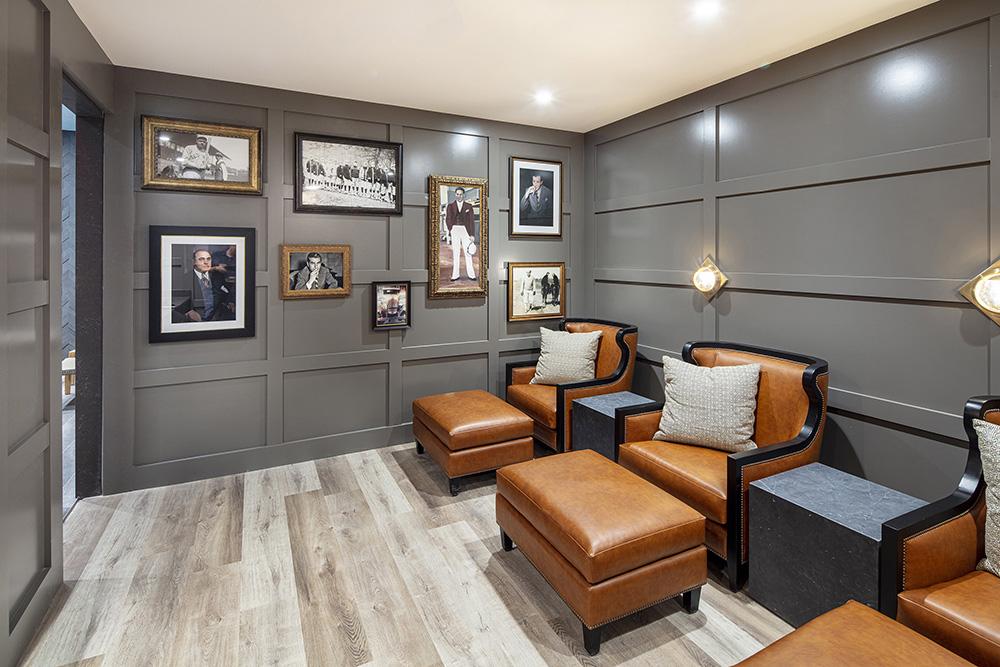 The resort’s new full-service spa and wellness experience is the first major spa to be built in the Spa City in more than a century. Guests can uniquely experience modern spa services in a nostalgic setting, including:
The resort’s new full-service spa and wellness experience is the first major spa to be built in the Spa City in more than a century. Guests can uniquely experience modern spa services in a nostalgic setting, including:
- An array of spa services, including couples' massages, hydro-facials, hot stone treatments, and a full-day Journey of the Springs experience with several additional offerings.
- Dedicated 1,925-square-foot women’s spa and 1,500-square-foot men’s spa, each with distinctly tailored parlors, dressing room areas and aqua thermal lounges featuring vintage-inspired needle showers that harken to historical bathhouses.
- A 750-square-foot full-service salon, multiple private treatment areas, and a co-ed lounge with upholstered chaise lounges and the area’s only Himalayan salt wall.
- Unique hot/cold wellness circuits in the large women’s and men’s aqua thermal areas, allowing guests to ‘Heat, Cool, Rest, Repeat’ in vapor rooms, infrared saunas, ice lounges, vitality pools, and thermal loungers.
- An illuminated wall of quartz crystal, an important healing element, in the reception area references crystal mining popular in this area of Arkansas, in celebration of the region’s natural resources.
I think what sets us apart is the level of service we provide to the guest, the beautiful aqua thermal areas that are located in each the men’s and women’s areas, and the services that we provide.
How would you describe your typical clientele?
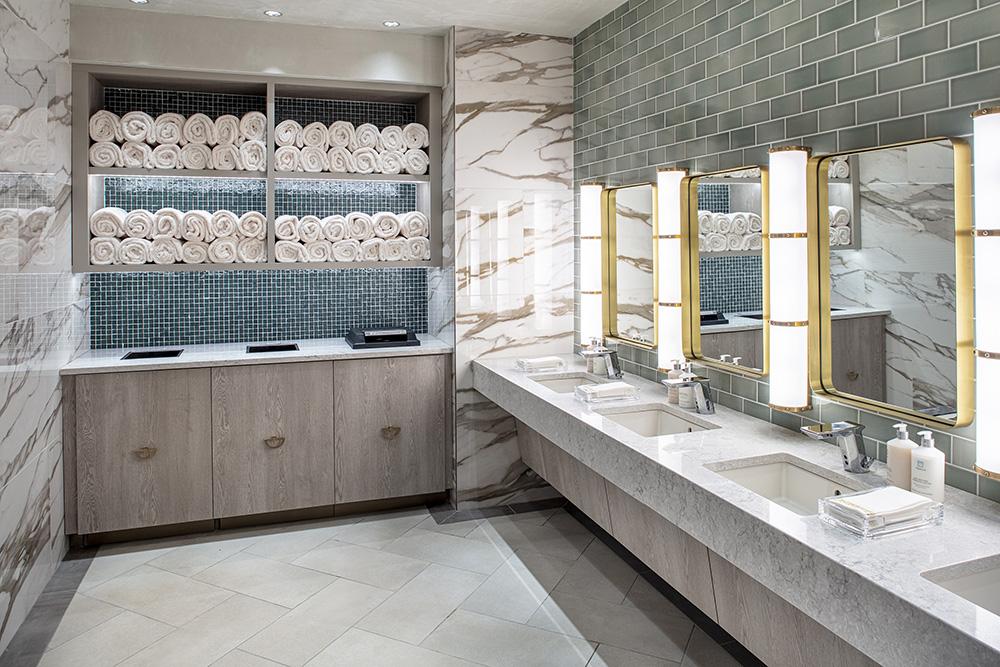 The typical clientele usually travels to Hot Springs for a weekend getaway from a city within a 200-mile radius of Hot Springs, AR. They usually come in for the weekend to see a horse race, gamble at the casino, or are celebrating a birthday or anniversary. Hopefully soon, we will be seeing guests that are specifically traveling here because of the spa. We see quite a few guests from Little Rock (the closest major city and the capital of Arkansas), as well as Memphis, TN, and Shreveport, LA.
The typical clientele usually travels to Hot Springs for a weekend getaway from a city within a 200-mile radius of Hot Springs, AR. They usually come in for the weekend to see a horse race, gamble at the casino, or are celebrating a birthday or anniversary. Hopefully soon, we will be seeing guests that are specifically traveling here because of the spa. We see quite a few guests from Little Rock (the closest major city and the capital of Arkansas), as well as Memphis, TN, and Shreveport, LA.
How are you marketing the spa to your hotel guests?
When a guest checks into the hotel, there is a key card offer from the spa for a $25 spa credit for a service 50-minutes or longer Monday through Thursday. Even if the guest isn’t here on a weekday, they could bring the card back during a week day to redeem their offer. The spa is also mentioned in their hotel reservation confirmation email, and present in the iPad compendium in their room. The in-room toiletries are from our bodycare line, Zents, that state they are available for purchase in the spa.
How are you marketing the spa to local guests or those not staying at the hotel?
 We run monthly specials that we send out in an email to our spa database, as well as post on the spa’s website under the Seasonal Treatments Tab. We have a pretty large following on Facebook from local residents. We have weekday treatment prices to encourage local guests to come to the spa during those days. In December, we launched a Sip & Spa menu that is a spa happy hour to encourage local guests to come in after work. This promotion is only available from Monday through Thursday from 2 p.m. – 7 p.m. Guests can choose a package, or one of our express services during those times as well as use of our full-service locker rooms and includes one glass of bubbly.
We run monthly specials that we send out in an email to our spa database, as well as post on the spa’s website under the Seasonal Treatments Tab. We have a pretty large following on Facebook from local residents. We have weekday treatment prices to encourage local guests to come to the spa during those days. In December, we launched a Sip & Spa menu that is a spa happy hour to encourage local guests to come in after work. This promotion is only available from Monday through Thursday from 2 p.m. – 7 p.m. Guests can choose a package, or one of our express services during those times as well as use of our full-service locker rooms and includes one glass of bubbly.
Can you tell me a little bit about the creation of the menu?
I worked with Susie Hammer, vice president of spas at WTS International, while creating the spa menu. I researched spa offerings in the area, as well as other casino resort spas, and Forbes Five-Star-rated spas. I wanted to keep the menu simpler, so the guest didn’t feel overwhelmed trying to decide between too many selections. I really wanted the guest to feel like we were creating something incredibly special just for them. After quite a few drafts, it went to the management team and the owners for edits and approvals.
We do offer signature Journeys that range 2 to 4 hours. The Journey of the Springs was inspired by our location. After you have changed into your robe and slippers, you are greeted in the parlor with a warm neck wrap, and a heated mineral foot soak and a cup of hot tea made from one of the local hot springs. Then in the treatment room, you receive a scrub, a soak with a eucalyptus and mint blend to draw in the vapors, an 80-minute massage with chakra balancing with locally sourced crystals, and a Rose Quartz Lift and Contour Facial. Throughout the journey, the guest is given a flight of water from the local hot springs in town. When the guest checks out, they are given an exclusive Journey of the Springs bath bomb made local in the state of Arkansas from Cotton Halo.
What are most spa-goers looking for when they visit your spa?
 The majority of spa-goers are looking to relax and are typically celebrating a special event in their life. The top-selling service is our 50-minute Heavenly Massage, followed closely by our 50-minute Couples Massage. Massage is 68 percent of our business.
The majority of spa-goers are looking to relax and are typically celebrating a special event in their life. The top-selling service is our 50-minute Heavenly Massage, followed closely by our 50-minute Couples Massage. Massage is 68 percent of our business.
What treatments are a harder sell? How do you promote them?
Our nail treatments are the hardest sell. We include them in our monthly promotions, and encourage other providers to cross promote.
What product lines do you carry at the spa?
Babor, Knesko, Foreo, NuFace, Zents, SachaJuan, Clove + Hallow, Jala Clothing, VitaJuwel Water Bottles
What do you find your biggest challenge to be, and how do you meet that challenge?
The biggest challenge is what everyone is currently facing, COVID--challenges with staffing, business levels, product arrival time, etc. I am meeting the challenge by being as organized as possible. We have a very heightened sanitation practice, we maximize our revenue on the busy days, so the slower days don’t hurt as much, and try to make sure I’m allowing ample time for the ordering process.
What plans do you have for the future?
For the spa, to become not only to be a great amenity of this amazing property, but to also become the reason people travel to Hot Springs.
InspireDesign Reveals the Inspired Mind of Practice Leader Nathan Peak
What energizes HBG Design’s new Practice Leader, Nathan Peak, as he takes on each new day? From good conversation that leads to fresh perspectives, to the freedom to let his body and mind run--InspireDesign magazine has the inside track on the personal and professional inspirations and collaborative mindset of HBG’s leader, Nathan Peak, AIA, LEED GA.
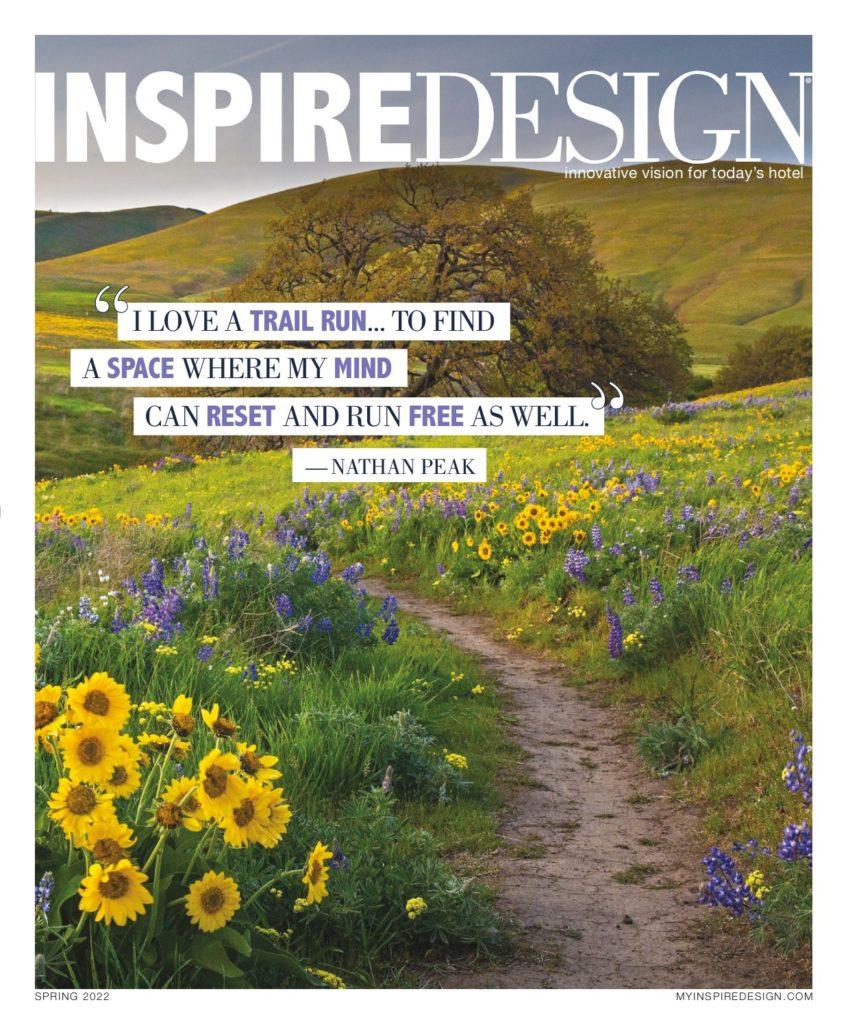

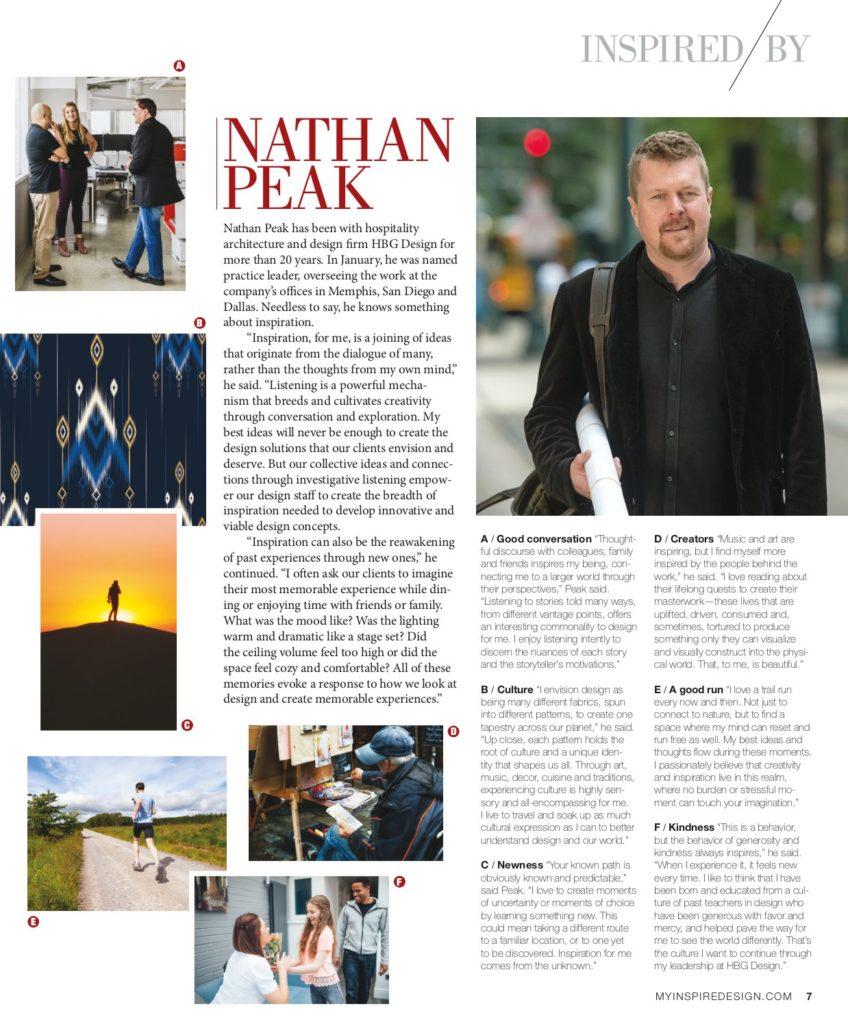

Nathan Peak has been with hospitality architecture and design firm HBG Design for more than 20 years. In January, he was named practice leader, overseeing the work at they company's offices in Memphis, San Diego and Dallas. Needless to say, he knows something about inspiration.
"Inspiration, for me, is a joining of ideas that originates from the dialogue of many, rather than the thoughts from my own mind," he said. Listening is a powerful mechanism that breeds and cultivates creativity through conversation and exploration. My best ideas will never be enough to create the design solutions that our clients envision and deserve. But our collective ideas and connections through investigative listening empower out design staff to create the breadth of inspiration needed to develop innovative and viable design solutions.
"Inspiration can also be the reawakening of past experiences through new ones," he continued. "I often ask our clients to imagine their most memorable experience while dining or enjoying time with friends or family. What was the mood like? Was the lighting warm and dramatic like a stage set? Did the ceiling volume feel too high or did the space feel cozy and comfortable? All of these memories evoke a response to how we look at design and create memorable experiences.
New Four Winds Casino New Buffalo Sportsbook Lounge is Designed for Comfort
Four Winds New Buffalo Casino Resort's newest amenity, the Sportsbook Lounge made the cover of the latest Tribal Government Gaming issue and was prominently featured in the "Sports of All Sorts" article. A small excerpt is below.
Sports of All Sorts
By: Roger Gros
See full article in Global Gaming Business' Tribal Government Gaming issue
https://issuu.com/globalgamingbusiness/docs/tribal_government_gaming_2022
Retail or Mobile
A retail book will soon become a staple for tribal casinos as sports betting continues to grow across North America. There’s really nothing like the excitement of an NFL Sunday or March Madness inside your casino when players can bet money on the games.
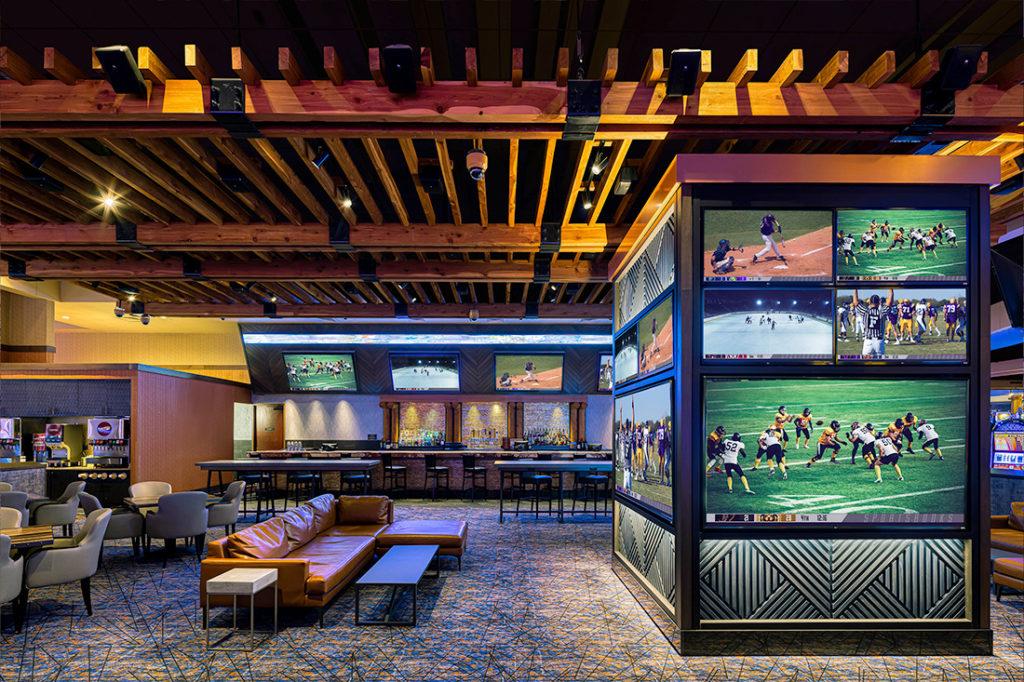

When HBG created the sportsbook at the Four Winds casino in New Buffalo, Michigan, it was designed for comfort. The Sportsbook Lounge is adjacent to the casino floor to take advantage of the surrounding gaming excitement. It’s designed to be a comfortable yet active retreat where guests can watch football, basketball, baseball and hockey action, while never having to leave the gaming floor environment.
The lounge’s custom layout and design provide sports fans with a comfortable ambiance to enjoy a beer while cheering on their favorite teams on any of the venue’s 22 televisions. Above the bar and on a large-scale central column are eight 85-inch, six 65-inch and eight 43-inch screens for ideal viewing from sectional sofas and lounge chairs, casual dining tables with chairs, and bar stool seating at the large sports bar.
Frank Freedman, chief operating officer of Four Winds Casinos, says the response of the customers has been very positive.
“We feel the layout, design and finishes will provide guests with the right ambiance, comfortable seating options and splendid views of multiple screens to enjoy a refreshing beverage or cocktail while cheering for their favorite teams,” he says. “Every addition we’ve made to our Four Winds Casinos locations has been for the sole purpose of enhancing the guest experience, and we’re thrilled to be able to offer this new amenity at Four Winds New Buffalo.”
Eagle Mountain Casino Named Top Tribal Project for 2022
See full list of Top Tribal Projects for 2022 in Tribal Government Gaming
HBG Design is excited to share that Tribal Government Gaming Magazine has selected Eagle Mountain Casino in Porterville, California as a Top Tribal Project for 2022.
Creativity & Innovation
The maturation of tribal gaming means constant change. Sometimes it’s a move of location, other times it’s enhancing what you already have. The tribal casinos that qualified this year are indicative of the changes in gaming overall. The legalization of sports betting and its introduction to existing tribal casinos have meant some creative use of existing spaces. The addition of amenities like hotel rooms and suites, high-class restaurants, spas and pools and more have given tribal casinos more of a resort feel, allowing them to compete for new customers whose entertainment wallets are ever-evolving. Congratulations to all the designers, thought leaders and tribal gaming operators who envisioned these amazing changes.
Right Place, Right Time
Eagle Mountain Casino, Porterville, California
Location, location, location,” says Joe Baruffaldi, AIA, principal/project manager at HBG Design, and leader of HBG Design’s San Diego Office.
“HBG Design’s client, the Tule River Tribe in California, is relying on their relocation to a high-visibility property in order to up their game and cement their reputation as a significant competitor in their regional gaming market just southeast of Fresno.”
The relocation of the casino from the reservation to a higher-traffic, higher-visibility area in Porterville, California creates a more conveniently accessible entertainment experience for their local customers, he says. It also opens new opportunities to capture destination traffic and overnight guests traveling between Fresno and Bakersfield.
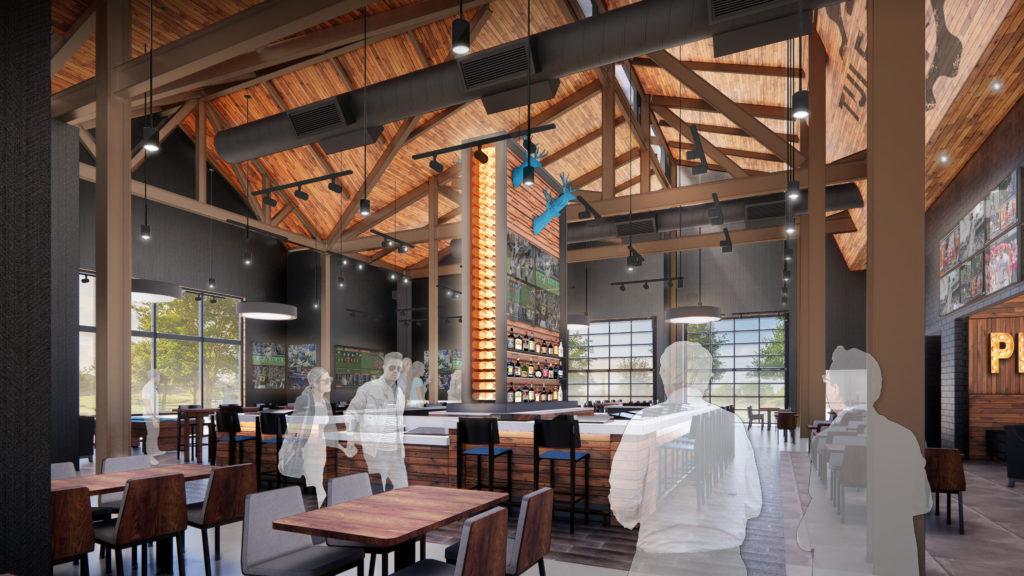

The new 105,000-square-foot casino property will offer 1,750 slots, 20 table games and a choice of four dining options, including a steakhouse, diner, café and sports bar and grill. A 2,000-seat event center and a 125-room hotel also will be added.


According to Baruffaldi, designers merged storytelling concepts based on significant Tule River tribal cultural elements with amenities and distinctive venues designed specifically for the Porterville gaming customer.
Key design concepts are rooted in the land and agrarian context of Tulare County and central California. The design is heavily influenced by a lodge aesthetic with wood and stone structural expressions. Inside, guests will experience an abstract depiction of the Tule River Tribe’s native traditions through art, patterns and imagery.
Soaring vertical features will recall the majesty of the giant sequoia and the golden eagle, each important representations of tribal culture. Flowing forms will recall the winding Tule River and organic curves of nature.
HBG’s design of the Eagle Mountain Casino feels connected to the woodland. Natural materials and colors help bring a sense of comfort for guests arriving at the property, for an overall relaxed and welcoming experience.
https://issuu.com/globalgamingbusiness/docs/tribal_government_gaming_2022
Tribal Gov't Gaming: Indian Gaming is Bouncing Back
See full article in Tribal Government Gaming
by Dave Bontempo
Tribal projects and gaming revenues rebound in the post-pandemic world
Bring back the aggressive gaming approach.
Tribal leaders and design firms say the “be-safe” phrase is morphing into “go-big” for the new post-pandemic world. Pent-up demand meets the resumption of competition, requiring tribal leaders to perform a balancing act. Operators seek the sweet spot incorporating must-see attractions, comfortable environments and realistic budgets.
As the American market emerges from Covid-19, projects become more forward-looking, far-reaching and sophisticated. Some of the nation’s most prominent companies help tribal leaders step forward.
Project Optimism
HBG Design unveils several operations with tribal leaders positioning themselves both for near-term and long-term success. Dike Bacon, principal, notes that U.S. commercial gaming revenues set an all-time record in gross revenue of $53 billion in 2021.
If this is any indication of the health and vitality of the Indian gaming industry (NIGC has not released 2021 figures), business is booming, he says. “Visit any casino in almost any domestic market and customer traffic is extraordinarily strong—inflation notwithstanding—and you see that demand is there,” he says.
Drivable trips are answering the call of most travelers’ curiosity, which has fueled the need to create fresh and exciting offerings in regional markets where many tribal casinos are located, he adds.
“Competition and location are often the driving forces behind whether a property needs a ‘must-see attraction’ as a differentiator and a draw, but any such ‘wow factor’ has to align with the property’s brand and target audience,” Bacon says.
“I’ll give you an example—we’re designing a distinctive feature attraction for events, music, daytime leisure and active nightlife, as part of a tribal casino resort expansion. The property has a formidable reputation as a leading entertainment and gaming destination, located within 30 miles of a metro feeder market of over 1 million people.
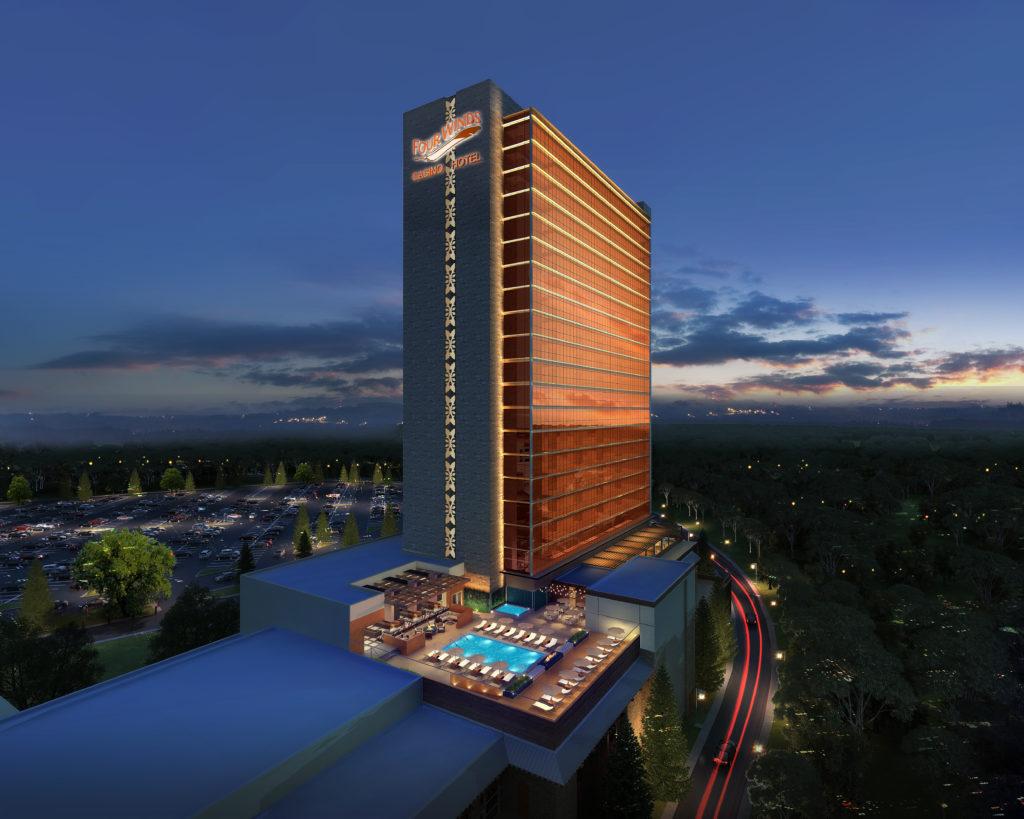

“Properties like this are able to support large-scale, high-impact, must-see attractions when their location combines a vibrant, diverse local population base and access to an equally strong destination customer who is willing to drive farther and stay longer to experience a distinctive amenity that is unmatched in the regional market.”
Bacon says HBG seeks innovative ways to help clients do more with less.
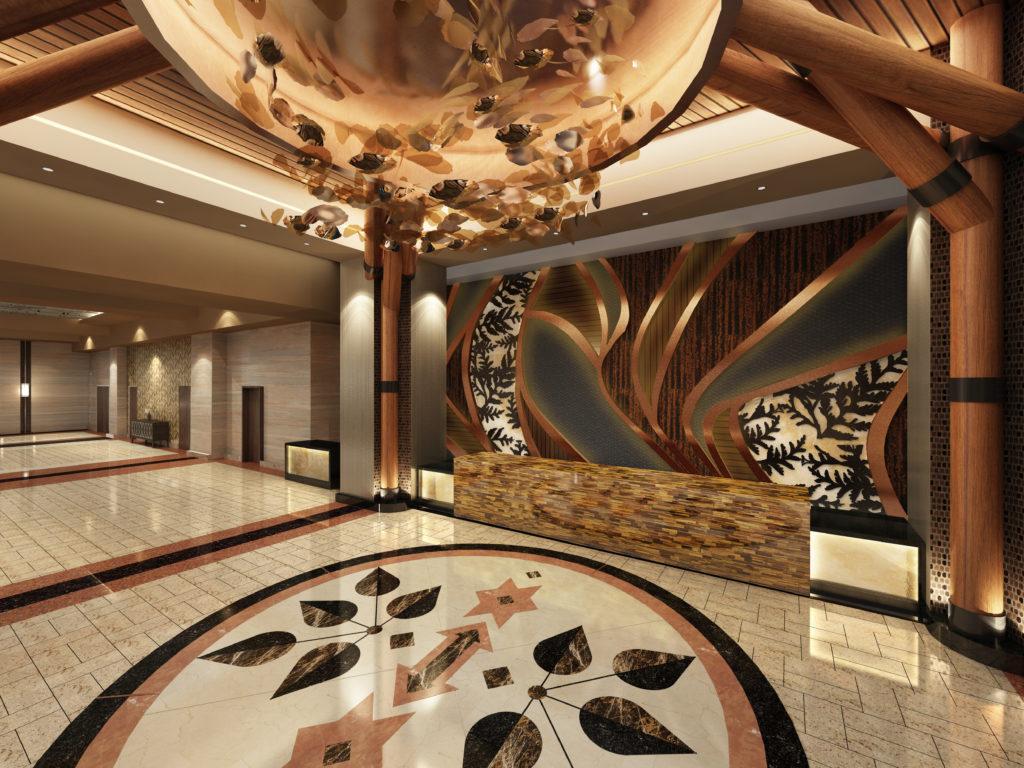

“This challenge covers a lot of ground, from designing public spaces and guest rooms that are easier and faster to clean and service to moving towards automation in concierge and casino hotel check-in,” he says. “Clearly, one of the biggest challenges for operators is to capitalize on current demand while still offering a great entertainment and hospitality experience with impressive customer service. Staffing in the entire hospitality industry (not just gaming) has been incredibly challenging.”
HBG designers work alongside owners to address these pressing issues. This includes creating more efficiently designed spaces that are exciting and entertaining but can also be operated with less staff.
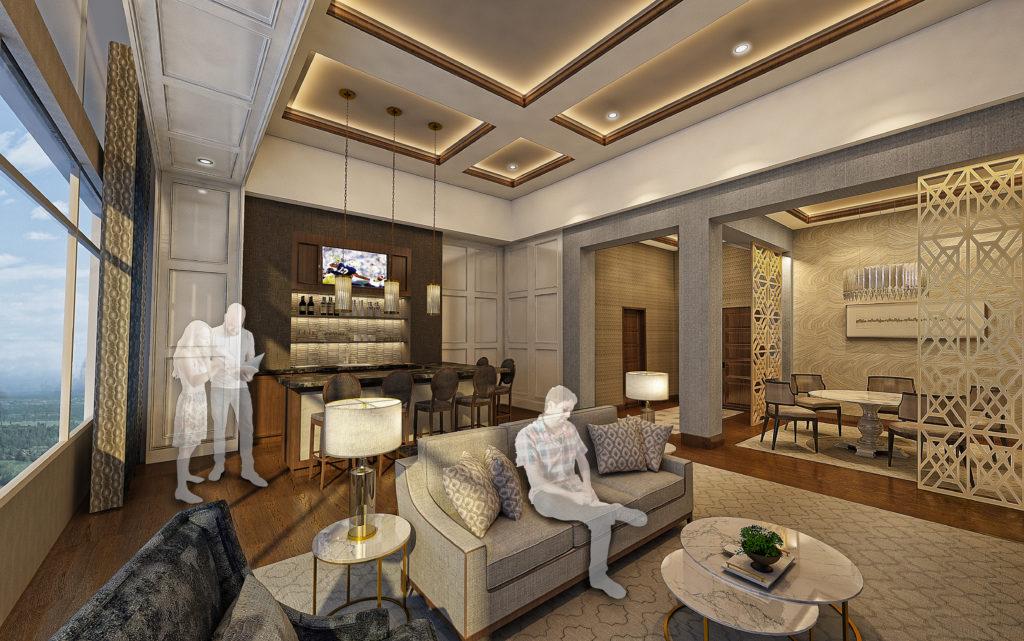

“We’re creating more efficient kitchens and more diverse means of providing F&B to customers, including self-service and take-out venues. Valet parking is another key service area affected by staffing shortages,” says Bacon.
“More customers may be encouraged to self-park instead of valet, which means designing and locating parking garages that are more convenient, secure and customer-friendly. It also gives rise to designing more elevated and exclusive VIP entrance experiences reserved for a property’s best players, creating a smaller staffing pool to focus service on the largest contributors to the casino’s bottom line.”
Nathan Peak, AIA, LEED GA, practice leader/principal of HBG Design, says pent-up demand for entertainment and hospitality experiences motivate tribes to upgrade underperforming areas of their facilities.
“Given the performance of the industry and how it is bouncing back from the pandemic, we are confident that owners will remain in expansion and renovation mode for a while,” Peak says. “A client recently told us that their gaming resort property will likely be in a continuous state of evolution, renovation and building over the next several years to stay fresh for guests and maintain relevancy in the market.”
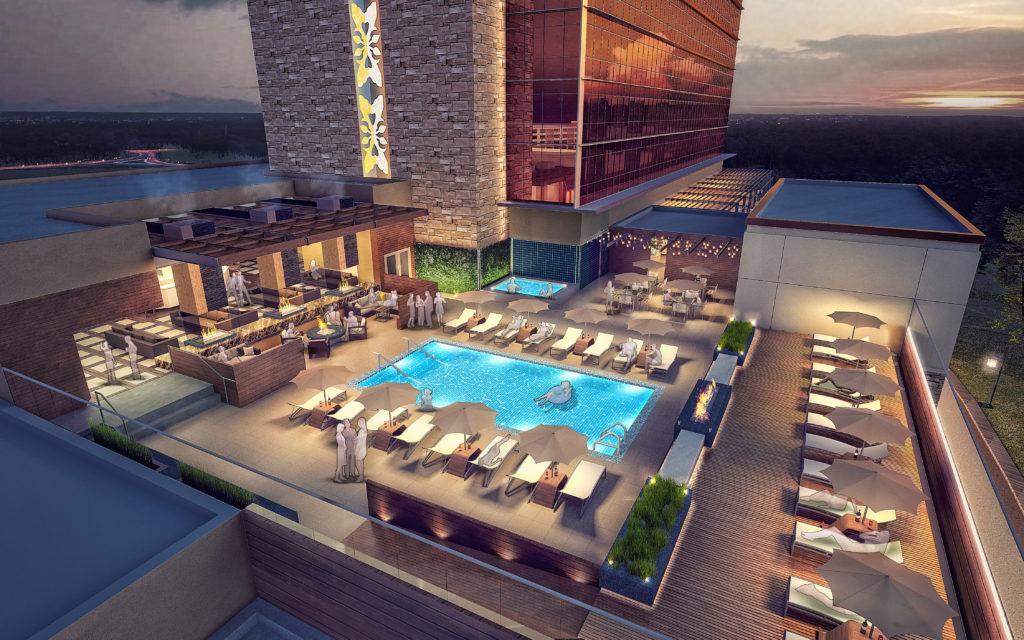

Another major influencer of the “continuous state of evolution” mindset is the continued passing of new legislation that drives change in tribal—and commercial—gaming properties, says Peak. As more states pass sportsbook legalization, that sets up new priorities for gaming properties who need “must-have” amenities to compete.
Tribes Take Assertive Stance
“Tribal gaming is definitely staying aggressive in terms of maintaining market share, especially in areas of the country where commercial gaming is growing and evolving,” adds Joe Baruffaldi, AIA, principal/project manager at HBG Design, and leader of HBG Design’s San Diego office.
“Tribes realize that knowledge is power; it’s what fuels a competitive edge,” he says. “There’s a greater need today for tribal casino owners to understand the nature of their customer base and harness the power of that knowledge—appreciating and leveraging not only where guests are coming from, but who they are as consumers.
“We partner with tribal gaming clients by helping them envision what the ‘tomorrow of their market’ looks like. When we’re able to anticipate changes in the marketplace, we can proactively respond by leading our clients to more competitively positioned design solutions.”
One of the highlights for HBG over the last few years has been its involvement in in the Four Winds South Bend casino in Indiana. The property is owned by the Pokagon Band of Potawatomi Indians, which operates three other casinos in Michigan.
Four Winds Casino embarks on a large-scale expansion of its South Bend property, designed by HBG, offering approachable luxury within a new 23-story, 317-key, 83-suite hotel tower.
The project includes a mix of vibrant amenities, to include a spa, convention area, meeting space, a ballroom, lounge, bar and grill, an outdoor rooftop swimming pool, and terraces with spectacular views.
The design incorporates regional elements and warm, rustic details with special attention and references to tribal influences and symbolism.


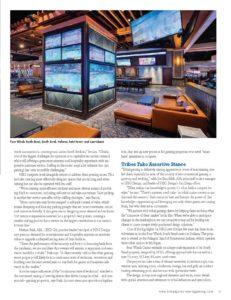

https://issuu.com/globalgamingbusiness/docs/tribal_government_gaming_2022
HBG Design's 'Women Who Lead' Honored by Memphis Business Journal
See full article in Memphis Business Journal
HBG Design is excited to share that our Chief Operating Officer, Terri Struminger and Director of Marketing and communications, Tamara Goff have been honored by Memphis Business Journal's editorial team as "Women Who Lead". This prestigious recognition highlights accomplishments of women who have broken through the glass ceiling and helped define their businesses, as well as the local marketplace.
Women Who Lead | Architecture: Terri Struminger of HBG
Terri Struminger not only acknowledges the rarity involving her role, but she champions it too. And rightfully so. She’s not an architect, though she’s successfully running the operations of HBG Design. “That’s been a very intentional hallmark of HBG’s organization for the past three decades,” she explained. Struminger leads the fully capable corporate operations team, so their “architects and interior designers are able to do what they love and do best: practice their craft, service our clients, and create exceptional projects.”
Next up on her agenda is leading new strategies and processes that integrate HBG’s core vision into every aspect of their team’s professional and personal development. Another big goal is to deepen employee engagement by rebooting some of the interactive aspects of our culture that have been altered because of the pandemic. “I am passionate about creating a ‘Best Place to Work’ culture at HBG Design,” she added, “and that sense of purpose drives absolutely everything I do.”
“I believe if you can share your organization’s values and priorities effectively, you can drive engagement in your workforce. With that in mind, my team and I set out on a journey to build greater awareness of our strategic vision and goals across the firm. I’m proud of the role I’ve played spearheading the evolution of HBG’s core vision. This has been a multiyear initiative that, so far, has clearly ignited a deeper connection between employees, firm aspirations, and culture.” - Terri Struminger, COO, HBG Design
Women Who Lead | Marketing: Tamara Goff of HBG Design
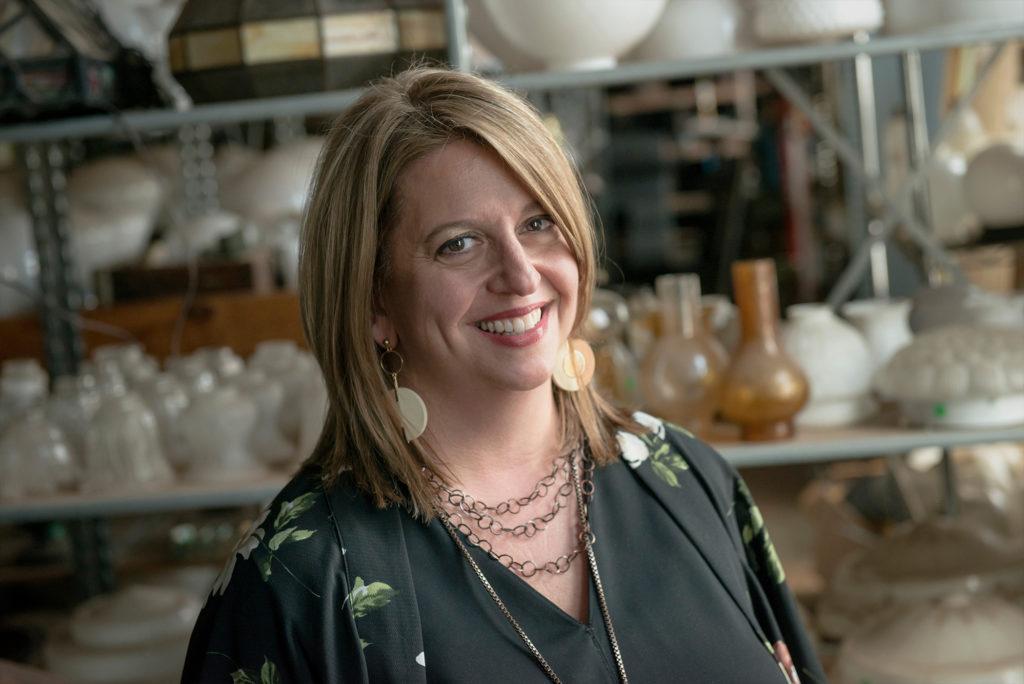

With more than two decades leading marketing efforts at HBG Design, Tamara Goff has a combination of skill sets that can often defy description. “What I do isn’t conventional. I’m a combination brand alchemist, creative influencer, communication ninja, aspiring novelist, culture curator, head cheerleader, and occasional cat wrangler,” Goff said. “Our CEO also tends to refer to me as ‘part of the conscience of the firm.’” More specifically, Goff is a principal and shareholder at HBG with a focus on influencing creative and strategic outcomes for the architecture firm. She points to the credibility established for her team in the industry, having garnered more than 30 national and international marketing and communication awards. And rebranding the firm to HBG Design in 2016 was a significant centering of the firm on its ‘true north’ and identity.
HBG's Five Trends for Transforming Hospitality Design in 2022
The pandemic has redefined hospitality design, but the reason why guests come together to share experiences hasn’t changed. It's more critical than ever to apply thoughtful, flexible and wellness-focused design sensibilities to hotel spaces, guestrooms and amenities. HBG Design Leaders Nathan Peak, AIA, LEED GA, Practice Leader, and Emily Marshall, IIDA, NCIDQ, Interior Design Director, present five trend ideas for transforming hospitality design into 2022.
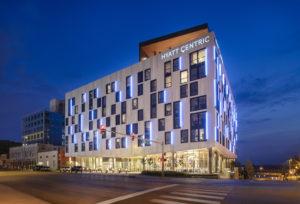

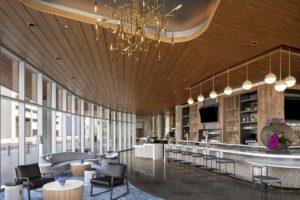
Multi-Functionality and Spatial Flexibility
Greater work flexibility has resulted in an increase of blended leisure and work travelers. We see a fresh reframing of hotel “zones” into residential-like multifunctional “work / dine / gather” spaces that easily align with evolving travel needs.
“The lines between work, travel, living and leisure are now blurred, which is a clear outcome of the pandemic.” - Emily Marshall
Many of HBG Design’s hotel and resort clients have re-prioritized their amenity offerings to provide an optimum alternative work environment for the “blended traveler”. To accommodate the blurring lines between work, travel, living and leisure, hotel lobby and public spaces are being designed in zones that easily shift from quiet virtual workspaces with auditory privacy to collaboration hubs for business interaction, to social areas depending on the needs of operators and their guests. The wide-open space idea is the foundational element, giving hotel operators the ability to blur the purpose of the space itself, based on the needs and wants of their guests. In fact, the in-room, remote work experience has – in many cases – become as important as delivering exceptional, traditional resort amenities, and that trend shows no immediate slow-down.
At Hyatt Centric Beale Street Memphis and Canopy by Hilton Memphis, both designed by HBG Design, we created residential inspired co-working zones with the idea of adaptable, flexible and technologically connected public spaces.
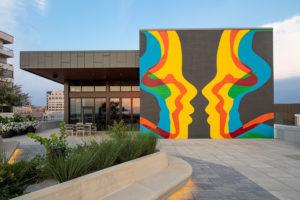
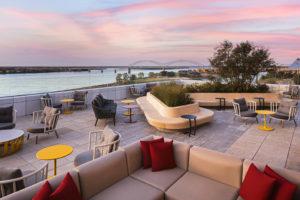
Experiential Design for Aspirational Travelers
Travelers are “breaking free” after months of pandemic isolation in some cases. Aspirational travelers are in search of memorable experiences and shareable moments inspired by art, architecture, design, history, and unique locales.
Hotels must offer new and creative experiences for guests in order to compete with the myriad of accommodation options in the marketplace, such as VRBO and SONDER. Local and regional materials, local artisans and custom design will all play a vital role in expressing authenticity in unique and artful ways, as designers seek to achieve an aesthetic that is “of the area” and create experiential moments.
At the Hyatt Centric Beale Street Memphis, HBG designers created a strong sense of place and a distinct ‘localvore’ Centric brand experience by drawing conceptual inspiration from Memphis’ rich music and riverfront industrial history. The contemporary hotel's staggered patterning of the window placement recalls sheet music and guitar fret patterns accentuated at night with bars of light to provide a musically inspired programmable light show. The Beck and Call rooftop whiskey bar features several selfie-worthy design opportunities like a colorful rooftop mural, the best river view in the city, and portraits of famed musicians with Memphis ties, including Tina Turner, Justin Timberlake, Isaac Hayes, Valerie June, and Yo Gotti.
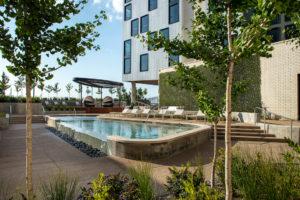
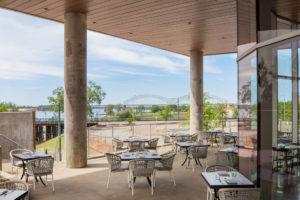
Restoration Through Nature
To enhance mental well-being, guests will seek out serene environments that offer respite and natural context that blurs the lines between indoors and outdoors. We anticipate an elevated demand for wellness-related amenities.
“The pandemic highlighted our need, as humans, to interact with nature.” - Nathan Peak
Humanity is hard-wired to seek physical and emotional connection with nature to feel healthier and more energized. It’s about creating a relationship between the interior and exterior that enhances guest responses to environmental stimuli and creates sensory experiences. Biophilic design methods underscore how a guest feels in a given space, which contributes significantly to experiential design. Bringing the outdoors inside through light, open design and integration of natural elements creates a feeling of restoration, wellbeing and happiness where guests respond positively --- a result every property seeks to achieve.
The architecture and shaping of the Hyatt Centric Beale Street Memphis lobby space creates beautifully framed views of the Mississippi River while dappling the public spaces with ample sunlight and reflections from the constant movement of the mighty river beyond. Outdoor Riverview dining and a landscaped pool and event courtyard “oasis”, complete with green lawn and a green wall, create a distinctive respite in the downtown core.

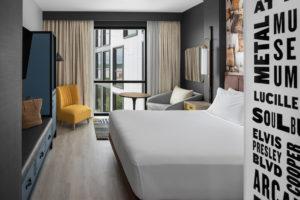
Guestroom Technology
Automatic technology will continue to advance the curated and customized guestroom experience offering options for convenience and comfort.
There are times when the greatest luxury in travel is knowing you’ll have no surprises upon arrival. Everything you want, exactly how you want it can be ordered and confirmed for your stay, before you ever walk through the hotel entrance. Not only can you check-in to your hotel room virtually, but you can select your room size, floor, view, accessibility to amenities, upgrades, etc. Access to no-contact services and experiences aren’t reserved for check-in; literally everything a guest wants or needs can be delivered directly to the guest room, and often by simply using voice commands from the comfort of your room. From voice-activated concierge services to voice or motion control of lighting, audio-visual systems, and room temperature, automation is proving to elevate convenience for the guest and permeating all aspects of the hotel experience.
"Within the room, I am especially fond of the motion detecting floor lighting technology designed into the beds in our Hyatt Centric Beale Street project. Gone are the trappings of navigating an unfamiliar room in the middle of the night; the integrated technology in our bed design creates a soft glow of light in the room as soon as your foot hits the ground." - Emily Marshall
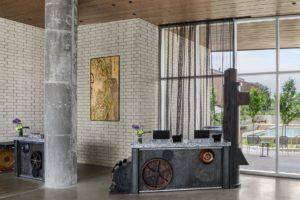

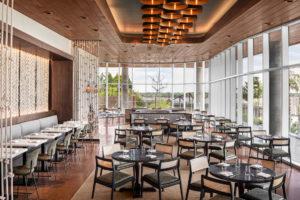

Regional and Early Material Sourcing
Material shortages, higher costs and longer-lead times are straining hotel project schedules. Regionally sourced materials will help overcome supply chain demand challenges. Procurement in the early design phases will help ensure construction availability.
“Carefully sourced regional options can not only circumvent such transportation and tariff issues, but they can also promote greater connection to place in meaningful ways.” - Emily Marshall
Many of these issues the industry is experiencing can be navigated during the early design phases with the right guidance from a knowledgeable team who understands the inner workings of available products and materials. Interestingly, we are seeing a stronger focus on the specification of domestic made products, which is good for the economy at large. The engagement of an experienced designer, construction company, FF&E procurement agents, and vendors early in the design process is critical, as products and materials quantities require early confirmation and additional lead time in ordering.
One way HBG Design is working around the supply chain situation is by using more regional manufacturers who employ skilled tradesmen who build case goods and millwork in a shop, versus working onsite. This not only keeps the level of quality high, but also increases efficiency of labor.
"HBG Design is looking at everything from design to delivery through a different lens heading into 2022, while reimagining the way spaces are used, designed, and furnished. And that, in the long run, will be better for everyone." - Nathan Peak
Nathan Peak Announced as HBG Design Practice Leader
Nathan will be focused on influencing design innovation, nurturing talent and leading HBG’s teams in delivering impactful hospitality design.
January 12, 2022 - Memphis, TN – HBG Design announces Nathan Peak, AIA, LEED GA, has been named Practice Leader of the 100-person, top 10 nationally recognized hospitality design and architecture firm. In his new role, Peak will oversee design and practice leadership for HBG’s three offices in Memphis, TN, San Diego, CA, and Dallas, TX. His promotion to Practice Leader represents the initial step in HBG Design's transition to its third generation of firm leadership.




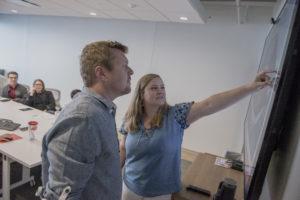

Peak is a principal in HBG Design's Memphis headquarters. Of his 20+ years with the firm, Peak has served as HBG’s Design Director for nearly a decade, leading and guiding the design direction of the firm’s national hospitality and entertainment projects.
“Nathan continues to be a transformative leader with immense creative vision and ambition for the firm’s growth,” says Rick Gardner, AIA, CEO of HBG Design. “He’s a champion of award-winning, experiential design and has a gift for cultivating talent and deepening the connections between employees across our organization.”
Peak plans to build on the firm’s deep bench of talented professionals to further position HBG Design’s national presence into multiple sectors of the hospitality industry.
“I’m energized by this generation’s sense of passion and purpose," says Peak. "I look forward to bringing a level of design leadership to the firm that is keenly focused on encouraging and engaging others to create something meaningful and impactful for our clients and those who experience the spaces we create.”
A core principle of HBG Design’s culture and vision is represented by the term ‘Ensuring Longevity.’
As HBG’s COO Terri Struminger describes, “We have a very distinct culture that connects our people and purpose and gives us opportunities to rally around common goals. One way we achieve longevity for HBG Design, our employees and their families is through smart transition planning that maps a clear path from the current generation of leaders to the next. Nathan’s elevation to Practice Leader is a significant moment on our path.”
An active father of a 13-year-old daughter and a 9-year-old son, the new face of HBG’s design practice knows first-hand the challenges of work-life balance facing today’s professionals.
“Like so many of our employees, I also balance bringing my absolute best to support our clients and the needs of our team – while managing a busy schedule of soccer tournaments and just being a dad,” says Peak. “I believe that a key aspect of corporate culture is keeping our work interesting and challenging, while enhancing work-life flexibility. We don’t just bring a part of ourselves to work each day – we bring our whole self. My goal is to really nurture an environment where everyone can bring their full life experience to what they do and know they are contributing something unique and important to the big picture.”
Peak is a graduate of the Pratt Institute in New York City where he earned his Bachelor of Architecture degree. He joined HBG Design in September 2001 as an architectural designer. His innovative hospitality and entertainment designs prominently stand out in the marketplace and have received national acclaim and multiple industry awards.
GGB Casino Style Highlights Changes in Post-Pandemic Design
https://issuu.com/globalgamingbusiness/docs/casino_style_magazine_2021/16
As Covid-19 reaches the rearview mirror of gaming operators, its future impact fits two distinct areas. Some properties have resumed pre-pandemic operations with a few tweaks. Others consider the post-pandemic world a permanent change for casino design. Casinos will incorporate safety-first measures and try striking a balance between safety, comfort, player cultivation and bottom-line innovations.
As casinos emerge from the pandemic, and resume investing in their operations, the design industry’s biggest players guide them forward, armed with the knowledge of which camp each property fits in.
GGB Casino Style Highlights Changes in Post-Pandemic Design
Making Lemons from Lemonade
Covid produced new realities, which breeds new opportunities in the eyes of HBG Design, a powerful group that has helped its clients get out in front of the pandemic.
“If there is such a thing as good news about ‘design after Covid,’ it’s the emphasis on flexibility and reinvention. Those two words have been a steady part of the gaming vernacular practically since its inception,” says Dike Bacon, principal at HBG Design.
“You have to keep your property fresh and in-step with trends in consumer behaviors, and while it may sound strange to think of ‘design after Covid’ as an opportunity, it represents one of the biggest shifts in consumer behaviors we’ve seen, possibly ever.”
HBG Design works with operators to re-think and re-invent communal spaces in their properties—from F&B to guest rooms, entertainment venues and, of course, the casino floor, he indicates. “These spaces will continue to play a vital role in connecting people; the design simply has to adapt and flex to support all of humanity’s newly redefined needs,” Bacon asserts.
Gaming-floor space provides another creative outlet. Although new ramifications have hit this area, the reason people gamble has not, according to Nathan Peak, AIA, LEED Green Associate, who also is a principal and design director at HBG. “The pandemic may have redefined the way we think about spaces—especially communal spaces,” Peak says, “but the reason why guests come together to share experiences hasn’t changed.
“The essence of these interactive entertainment spaces hasn’t been lost. Casino resort amenities and especially the casino floor thrive on big spaces teeming with lots of energy and people, and they always will.”
Applying thoughtful, flexible design sensibilities to communal gaming spaces and amenities is more critical than ever before, as these spaces must now be able to easily transform and handle fluid situations, he indicates.
“The key,” says Peak, “is reimagining what flexibility looks like. Before Covid, flexibility may have meant stackable furniture or retractable event space seating, but the word flexibility has been redefined because of the pandemic. Today, we look at flexibility as shaping spaces that are malleable and can adjust to a host of layout options suitable for individual privacy, groups, and social interaction.
“Ultimately, it’s about designing flexible spaces that cater to flexible needs. The ideas of physical space and user experience are more connected than ever before, as people may still feel wary of sitting close to others, yet don’t want to be in isolation.”


High Limits area at Oaklawn Racing Casino Resort/HBG Design
The idea of adaptable and flexible public spaces can be seen throughout HBG Design’s recently completed Oaklawn Racing Casino Resort in historic Hot Springs, Arkansas. Across the property one sees influence of “design after Covid,” Peak asserts, noting its soaring hotel lobby space designed with a number of different interaction zones that easily shift from quiet personal spaces to socialization hubs for groups to gather before heading to the casino floor.
Flexible FF&E accompanies thoughtfully considered layouts that can be easily changed and reconfigured depending on the needs of operators and their guests.
“In the Oaklawn Racing Casino Resort lobby, we’ve used bold architectural gestures like the grand staircase and escalators which create dramatic structural elements and strong visual presence that directs casino guests to the main gaming floor, new food court and the hotel guest rooms on the second level,” Peak indicates. “Every space needs a moment that pulls you in, and these central elements draw you in, create interest and also provide a sense of openness in the space that puts guests in the right frame of mind—that they’ve entered not only a beautiful, glamorous entertainment space, but a safe space to enjoy.”
The pandemic has also seriously affected regional material sourcing, which plays a vital role in the architecture, engineering and construction (AEC) industry.
Bacon says a new sensibility about sourcing materials from regional makers and manufacturers has come out of the pandemic. “As designers seek to achieve an aesthetic that is of the area and create experiential moments, local and regional materials play a vital role in expressing that authenticity.
“Where the pandemic comes into play is in the material shortages, higher costs, and longer lead times the entire AEC industry is experiencing today,” he adds. “Covid created significant manufacturing shutdowns, especially overseas, leading to material shortages and often complete lack of availability, higher tariffs from international manufacturers shipping domestically and transportation concerns. As an alternative, carefully sourced regional options can not only circumvent such transportation and tariff issues, but they can also promote greater connection to place in meaningful ways.”
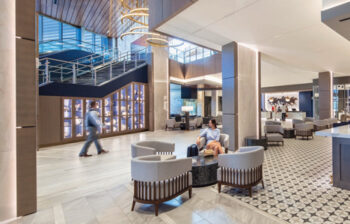

Lobby area at Oaklawn Racing Casino Resort/HBG Design
The effects of Covid extend to another area, the disrupted supply chains.
“Supply chain issues will probably go on for another year or so,” says Emily Marshall, IIDA, NCIDQ, principal and director of HBG Design’s Interior Design Group. “Many of our clients in the branded hospitality space, as well as in gaming, have told us they are looking at 30–32-week lead items for most of their FF&E and lighting. That makes a big impact on accommodating anticipated construction and installation schedules.”
One way HBG Design is working around the supply chain situation is by using more regional manufacturers who employ skilled tradesmen who build case goods and millwork in a shop, versus working onsite. This not only keeps the level of quality high, but also increases efficiency.
“We’re very supportive of this type of FF&E delivery because the craftsmanship is excellent and there is so much less waste as a result,” adds Marshall. “Like Dike said, if there can be any sort of ‘good’ outcome of the pandemic, it’s that our eyes have been opened to looking at everything from design to delivery through a different lens, while reimagining the way spaces are used, designed, and furnished. And that, in the long run, will be better for everyone.”
Read the full article above, and here.
Designing for the Caption brand - InspireDesign Magazine interviews the new brand's lead designer
See Full Story in InspireDesign Magazine
Hospitality design firm HBG Design is embracing the new Caption by Hyatt brand with a focus on redefining what hospitality looks like in the modern world; and it couldn’t come at a better time. The first U.S.-located Caption by Hyatt hotel, and second to open worldwide, is a beacon of hope following widespread disruption to the hospitality industry caused by the pandemic. Caption by Hyatt’s upscale, select-service lifestyle brand is targeted to conscientious locals and guests, with a focus on creating social spaces that punctuate connection and interaction with their locale. The Memphis, TN location celebrates the spirit of this iconic American city, steeped in history with many stories to tell.
Caption by Hyatt will become an integral component of downtown Memphis’ One Beale mixed-use development located at the base of Beale St. on the Mississippi River bluff, and will connect with the adjacent Hyatt Centric hotel, also designed by HBG Design, which opened to guests on April 15.
We spoke with Mark Weaver, FAIA, principal/senior architectural designer, HBG Design, who is leading both the architectural design and interior design of the project:
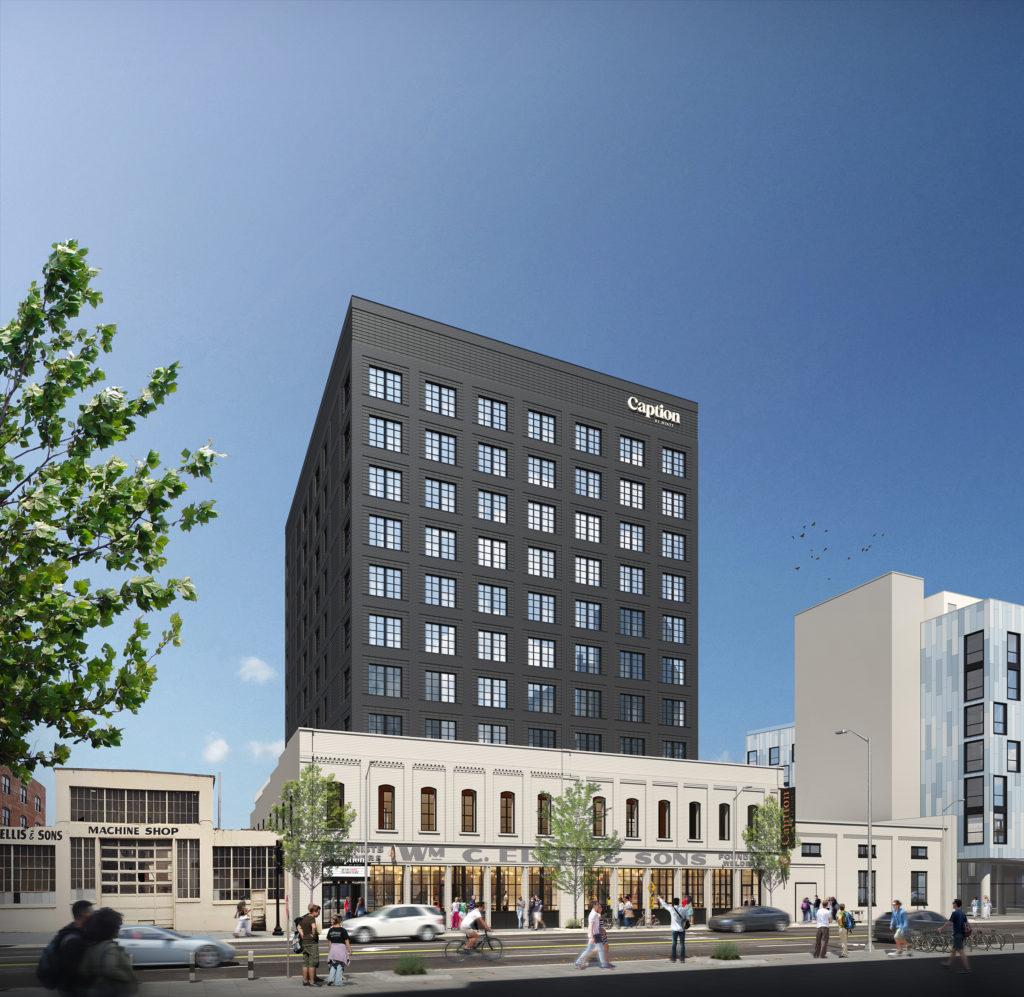

When complete in 2022, the new Caption by Hyatt hotel will become an integral component of downtown Memphis, Tennessee’s One Beale mixed-use development…The new development represents a merging of vibrant live/work/play functions among downtown Memphis’ landmark structures.
Each hotel sits prominently within the One Beale development offering its own distinct interpretation of brand and Memphis history and culture. Specifically, the new Caption design will offer an inimitable contemporary boutique hotel experience while paying homage to Memphis’ historic riverfront legacy and industrial architectural vernacular.
Where and how do you seek your inspiration?
Inspiration comes from so many places for our hospitality designers—local culture and the regional landscape, branding and market influences, our clients’ project visions, storytelling, and biophilic, sustainability and wellness concepts. We design hospitality and entertainment projects all over the U.S., in both urban and more agrarian environments, and design language based on regional context and culture resonates highly with our clients and their guests.
The Caption hotel benefits from our designers’ knowledge of Memphis; this is HBG Design’s home and has been our company headquarters since 1979, even before we added our San Diego and Dallas office locations. The hotel property is situated in downtown Memphis, a hub of activity near the banks of the Mississippi River, and not far from our design studio. The city has a long industrial history with rows of ornate brick warehouse buildings lining the downtown streets. Our designers walk these streets daily and are inspired by the city’s former life and the possibilities for its current and future growth.
How did local culture, landscape and history influence the design?
Design influenced by local flavor is an important aspect of the guest experience. For example, the hotel design is being integrated into the historic architectural remains of the William C. Ellis & Sons Ironworks and Machine Shop building on Memphis’ Front St., which will house the hotel’s ground and second floors.
The Ellis company was one of the earliest, longest-running businesses in Memphis. The original blacksmith shop once made wrought-iron straps for carriages and shoes for horses and mules, and other structures on-site were used for river trade manufacturing and the repair and building of agricultural machines such as cotton compresses and railroad equipment.
Conceptually, the integration of the historic Ellis facade serves as a distinguishing artifact that will be remembered and appreciated as part of Memphis history.
The Caption’s 136-key hotel guestroom tower will then rise dramatically above the Ellis facade offering guests superb views of the river and the city skyline. The tower’s modern, darker exterior is designed to complement the light-colored Ellis building in front.
The interior design concept reflects this duality with a comfortable, refined ambiance featuring subtle references to the industrial roots of the hotel’s location highlighted with soft colored tones and metal accents. The guestrooms will reveal uniquely designed custom furniture that offer signature touches of comfort and luxury.
How do you define a design vision for the first U.S. property of a new brand?
At the heart of the Caption by Hyatt brand experience will be the F&B concept Talk Shop, which will serve as a welcome area, all-day lounge and workspace, coffee shop, eatery, grab-and-go artisanal market and cocktail bar. A patio and beer garden courtyard will be incorporated into the building’s historic Ellis facade on Front St. The unpretentious style and approachability of the space combines with locally inspired experiences, ideal for socializing and appealing to both travelers and locals.
Additionally, each Caption hotel builds on signature brand features, including marquee signs above each main entrance, local hand-drawn graphic art and animated social and F&B spaces with tech-forward features like digital check-in, digital keys and mobile-order food service.
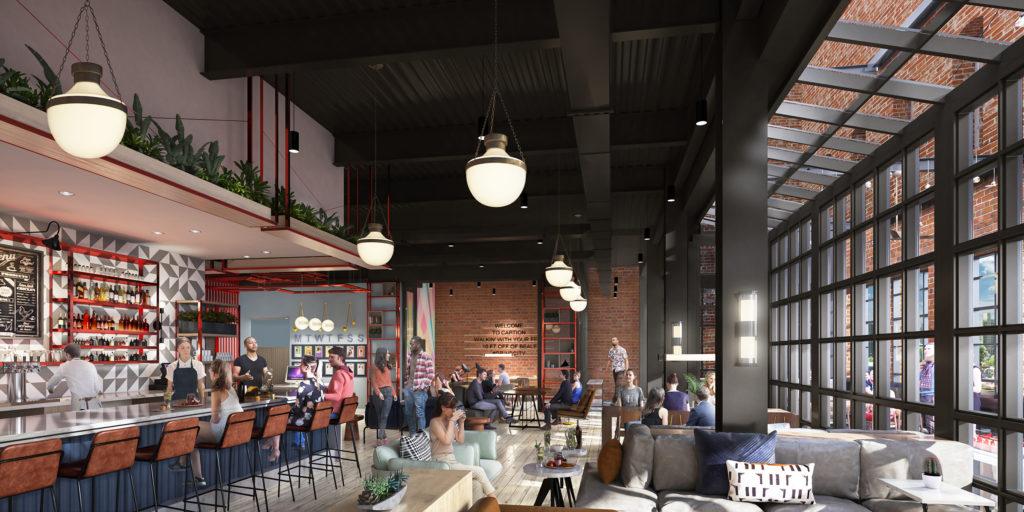

There are always challenges when integrating historic structural elements with new builds, but HBG Design is accustomed to this challenge through our 40-plus years of experience revitalizing other historic projects, many of which are in downtown Memphis. We are intimately familiar with these older Memphis buildings and appreciate the opportunity to reuse and integrate the long-vacant Ellis Shop on Front St., which has been adapted to hold Talk Shop lounge space and hotel meeting space. Talk Shop’s double-height lounge will be enveloped by the historic building’s original heavy timber framing, decorative brick walls, archways and clerestory windows. The historic building will also accommodate the new Foundry Ballroom and new meeting rooms with names like the Welding Shop and Pattern Shop, serving as a connecting point between the Hyatt Centric and the Caption by Hyatt properties.
Is there anything else readers should know about the hotel and its design?
Developed by Carlisle Corporation, the Memphis Caption by Hyatt hotel is currently in construction with an expected opening date of spring 2022. HBG Design has worked with Carlisle Corporation for over 15 years exploring and leading the planning and design for the One Beale mixed-use development through multiple iterations of development possibilities.

